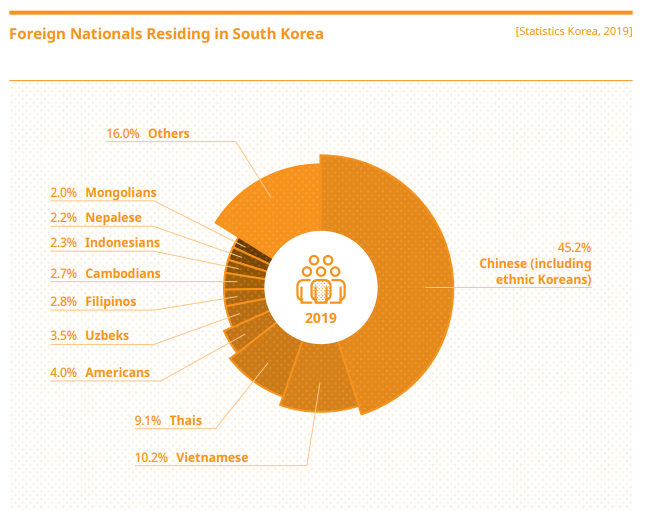South Korea has long been a culturally homogeneous society, but the number of migrant workers and foreign students has rapidly increased since the end of the 20th century. According to the Population and Housing Census conducted in November 2018, the number of foreign nationals residing in the country stood at 1.65 million, accounting for nearly 3.2% of the total population, and 46.0% of these were Chinese nationals.

Recently, the rapidly growing number of multicultural households has reached 330,000, which is largely attributed to increasing international marriage. The government launched an office dedicated to providing support for foreign citizens’ social activities within the country and enacted the Multicultural Families Support Act. Under the act, 228 multicultural family support centers (www.liveinkorea.kr) are in operation as of 2020 across the country to provide the following services: Korean language education sessions designed to help foreigners adapt to life in Korea; psychological counseling; events for experiencing the cultures of foreign spouses; and employment support programs with affiliated agencies such as Saeil Center (Career Development Center for career interrupted women).
The South Korean government has recognized the importance of disparate foreign cultures and thus is taking diverse measures to avoid social problems arising from the inflow of foreign cultures. One of those measures is to support the transformation of multicultural villages into tourist destinations.
Chinatown in Seollin-dong in Incheon is one of the representative examples of a unique foreign culture in South Korea. Its history began when ethnic Chinese settled there to do business by taking advantage of the geographical proximity to China during the modernization in the late 19th century. Nowadays, serving as a forward base for exchanges with China, this area has also emerged as a new cultural tourism destination for enthusiasts as its history and culture are drawing public attention.
Another example is the Ansan Multicultural Village Special Zone in Gyeonggi-do. People from China, India, and Pakistan living in the zone can purchase specialties of their home countries. Seoul is well-known for its global villages: the Japanese Village in Ichon 1-dong and the Muslim village around the Seoul Central Mosque in Itaewon-dong, both of which are located Yongsan-gu; the French village called Seorae Village in Banpo-dong, Seocho-gu; the Vietnamese town in Wangsimni, Dongdaemun-gu; and the Nepalese town in Changsin-dong, Jongno-gu.
In 2013, the Seoul Metropolitan Government chose Daerim 2-dong in Yeongdeungpo-gu, in which a large number of foreigners reside, as a trial area for a project to invigorate multicultural village communities. Subsequently, a new cultural complex center, Dadeurim Cultural Center, was opened in the area in March 2018.
Currently, a number of foreign-born Koreans are serving as public officials in the central or local governments. Foreign residents with various cultural backgrounds are also actively working in the broadcasting industry. Their participation will greatly contribute to the creation of an environment where diverse cultures coexist in harmony, and even to social integration.

Recently, the rapidly growing number of multicultural households has reached 330,000, which is largely attributed to increasing international marriage. The government launched an office dedicated to providing support for foreign citizens’ social activities within the country and enacted the Multicultural Families Support Act. Under the act, 228 multicultural family support centers (www.liveinkorea.kr) are in operation as of 2020 across the country to provide the following services: Korean language education sessions designed to help foreigners adapt to life in Korea; psychological counseling; events for experiencing the cultures of foreign spouses; and employment support programs with affiliated agencies such as Saeil Center (Career Development Center for career interrupted women).
The South Korean government has recognized the importance of disparate foreign cultures and thus is taking diverse measures to avoid social problems arising from the inflow of foreign cultures. One of those measures is to support the transformation of multicultural villages into tourist destinations.
Chinatown in Seollin-dong in Incheon is one of the representative examples of a unique foreign culture in South Korea. Its history began when ethnic Chinese settled there to do business by taking advantage of the geographical proximity to China during the modernization in the late 19th century. Nowadays, serving as a forward base for exchanges with China, this area has also emerged as a new cultural tourism destination for enthusiasts as its history and culture are drawing public attention.
Another example is the Ansan Multicultural Village Special Zone in Gyeonggi-do. People from China, India, and Pakistan living in the zone can purchase specialties of their home countries. Seoul is well-known for its global villages: the Japanese Village in Ichon 1-dong and the Muslim village around the Seoul Central Mosque in Itaewon-dong, both of which are located Yongsan-gu; the French village called Seorae Village in Banpo-dong, Seocho-gu; the Vietnamese town in Wangsimni, Dongdaemun-gu; and the Nepalese town in Changsin-dong, Jongno-gu.
In 2013, the Seoul Metropolitan Government chose Daerim 2-dong in Yeongdeungpo-gu, in which a large number of foreigners reside, as a trial area for a project to invigorate multicultural village communities. Subsequently, a new cultural complex center, Dadeurim Cultural Center, was opened in the area in March 2018.
Currently, a number of foreign-born Koreans are serving as public officials in the central or local governments. Foreign residents with various cultural backgrounds are also actively working in the broadcasting industry. Their participation will greatly contribute to the creation of an environment where diverse cultures coexist in harmony, and even to social integration.
